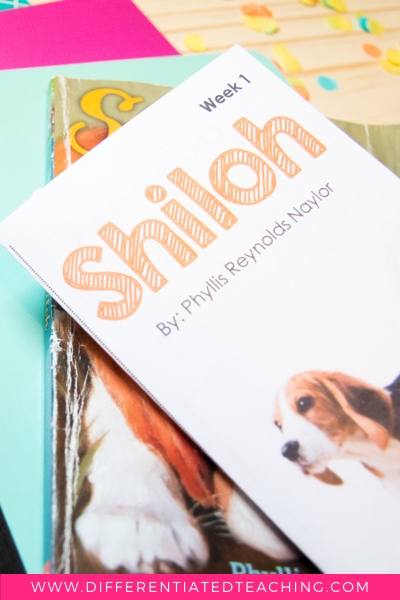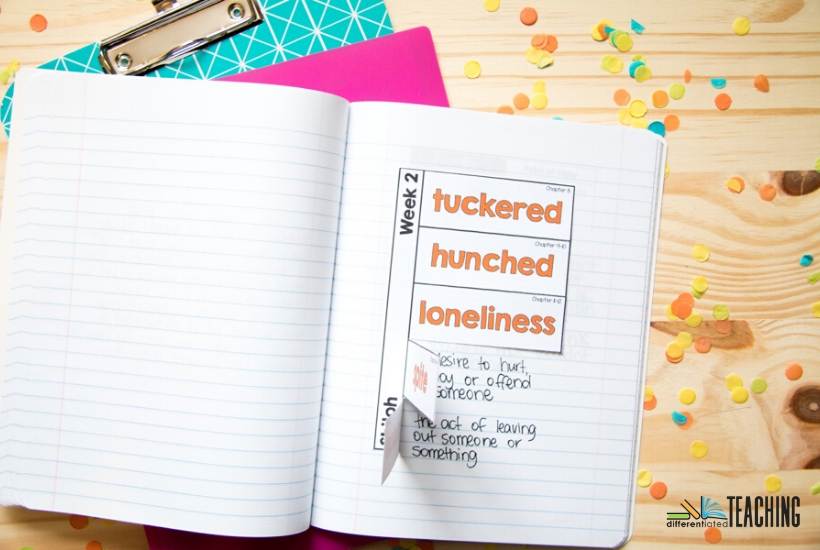Shiloh Novel Unit: Ideas & Activities for your Next Lit Study
Phyllis Reynolds Naylor’s classic novel Shiloh has long been a classic favorite. The book is perfect for a whole-class novel study or read-aloud in third-grade classrooms, or it can be used as a book club or literature circle text for 4th-6th graders. In this post, I’ll share resource recommendations, free teaching ideas to kick off and wrap up your Shiloh book study, and some helpful information about the book. When you finish this post, you’ll feel confident and ready to rock your literature unit.


Shiloh Summary
Shiloh is the story of an 11-year-old boy named Marty and a young beagle. After instantly falling for the beagle he finds in the woods behind his home, Marty is horrified to discover the pup belongs to his neighbor, Judd Travers.
Judd is a heavy drinker, carries a gun, and abuses his dogs. After being forced to give Shiloh back, Marty is both thrilled and terrified when he reappears. Realizing he must hide Shiloh, Marty secretly keeps him safe.
However, secrets are hard to keep, especially when they impact your whole family. It isn’t long before tragedy strikes, and Marty must make a difficult decision. Will Marty keep Shiloh or return him to his former home?
What reading level is Shiloh?
This book is a Guided Reading Level R and has a Lexile score of 890L. Appropriate for third through eighth-graders, the book has many issues that may be more challenging for younger learners to break down and process. You’ll want to approach the text differently depending on the age of your students.
At a DRA level 40, the book should be a relatively easy read for 5th-8th graders. This will allow you more opportunity to dive deep into the moral and ethical issues facing the main characters.

Spark Curiosity with these Pre-Reading Activities for Shiloh
If you’re looking for some great pre-reading activities to activate your students’ background knowledge and get them ready to soak up all the valuable lessons you’ll be teaching through your novel study, you’ve come to the right place. Here are some great activities you can use to get your learners in the right frame of mind for your Shiloh novel unit:
- Man’s Best Friend: Discuss the qualities that make dogs good companions. What roles do they play in our lives? Students can create a word web or drawing depicting the positive aspects of dog ownership. This taps into the bond between Marty and Shiloh.
- Shades of Gray: Discuss the concept of right vs. wrong. Are there ever situations where the lines blur? Present a moral dilemma (e.g., finding a lost wallet with money) and have students brainstorm different courses of action. This foreshadows the ethical conflict Marty faces with Shiloh.
- Animal Rescue Awareness: Invite a speaker from your local animal shelter or a rescue organization in your area to discuss their role in your community. This can help students begin to think about the important role animal rescuers play and how challenging this work can be at times. If you’re homeschooling, you might even find a day to go volunteer at one of these organizations!
- Mysteries of the Wild: Conduct some brief research on different dog breeds and the jobs they’ve had historically. Students can create short presentations or drawings showcasing different breeds and their historical roles. This provides context for Shiloh’s wild nature.
Depending on the time you have available and your learners’ interests, one or more of these activities might be a better fit for your students. Since you know your students best, choose what you feel will be best for getting students ready to dive into your novel unit.
Engaging Activities Beyond Book Reports for Shiloh
As you wrap up your book study, consider adding a few activities to help your students synthesize and share their understanding. These post-reading activities will help extend the themes and big ideas students should take away from Shiloh beyond the reading experience. These hands-on projects, interactive challenges, and creative endeavors help students make connections with the story that they can carry with them for years to come.
- Letter to the Author: Have students write a letter to Phyllis Reynolds Naylor, the author of “Shiloh.” In their letter, students can express their thoughts and feelings about the book, ask questions about the characters or plot, and share how the story impacted them personally.
- Compare and Contrast: Assign students to compare and contrast the character of Marty from “Shiloh” with another protagonist from a different book they have read. They can analyze similarities and differences in their personalities, motivations, and relationships with other characters.
- A Day in Shiloh’s Life: Have students create a journal entry from Shiloh’s perspective, detailing his experiences before meeting Marty. They can write about his life in the wild, his struggles to adapt to captivity with Judd Travers, and his growing bond with Marty. This activity helps students explore Shiloh’s thoughts and emotions as he navigates different stages of his life in the book.
- Book vs. Movie Comparison: Have students watch the movie adaptation of “Shiloh” and compare it to the book. They can analyze differences in plot, character development, and themes, discussing which version they prefer and why.
- Field Trip to an Animal Shelter: Organize a field trip to a local animal shelter where students can volunteer or observe how dogs like Shiloh are cared for and rehabilitated. They can reflect on the similarities and differences between the shelter environment and Marty’s experiences in the book. Alternatively, look into whether your area as a beagle rescue organization.
- Character Scrapbook: Invite students to create a character scrapbook for Marty or Shiloh, compiling photographs, drawings, and written reflections that depict key moments and emotions from the book. They can include diary entries, quotes, and memorabilia to bring the character to life.
- Dear Judd Travers: Write a letter from Marty’s perspective to Judd Travers, expressing his feelings about Shiloh and the situation. Students can delve into Marty’s emotional journey, discussing his love for Shiloh, concerns about the dog’s well-being, and moral dilemmas he faces. This activity encourages students to empathize with Marty’s character and analyze his relationships in the story.
- Shiloh’s Ballad/Song: Imagine Shiloh could write a song about his experiences. Students can write lyrics from Shiloh’s perspective, expressing his emotions and longing for freedom. They can incorporate themes of loyalty, survival, and the bond between humans and animals, reflecting Shiloh’s journey throughout the book. This creative writing activity allows students to explore Shiloh’s inner world and the challenges he faces in the story.
- Doggone Debate: Organize a mock debate about the ethics of hunting dogs, inspired by the conflicts in “Shiloh.” Students will research arguments for and against hunting dogs, considering whether it is a necessary practice or a form of cruelty. They will present their findings persuasively, drawing parallels to Judd Travers’ hunting practices and Marty’s ethical dilemmas in the book.
- Unlikely Friends: Inspired by Marty and Shiloh’s unlikely bond, students will create a short story or comic strip depicting an unlikely friendship between two very different characters. They can explore themes of trust, loyalty, and understanding, similar to Marty’s relationship with Shiloh. This creative activity encourages students to reflect on the dynamics of friendship and acceptance portrayed in “Shiloh.”
- Create a Pet Care Guide: Have students create a pet care guide for caring for a dog like Shiloh. They can include sections on nutrition, grooming, exercise needs, and training tips based on what they learned from the book.
- Dog Shelter Design Project: Have students design and build a model of a dog shelter. Using cardboard or foam board, they’ll create a space that reflects the safe haven Marty provides for Shiloh. Encourage them to consider amenities like beds and play areas, fostering empathy and practical design skills as they bring the story to life through their creations.
The Shiloh Novel Study Guide
While you’ve probably got some great ideas picked for your pre- and post-novel study activities. You might be wondering what you’ll do while you’re actually reading the book. Since I’ve written over 300 novel units, I’ve got you covered there, too!
All of my novel studies come with an instructional guide to help make planning a breeze. In addition, you’ll find PDF printables that focus students on key reading comprehension skills and text-based vocabulary in a student-friendly format that won’t overwhelm them or take away from the story by inundating them with those lists of questions you often get with book study packets.

This Shiloh book study includes everything you need for a two-week (10-day) novel unit. With a single comprehension and vocabulary focus each day, you’ll maximize student learning and engagement with the text.
Here are some of the comprehension skills covered in the Shiloh novel study:
- Inferring character emotions
- Analyzing characters & setting
- Identifying the main idea
- Point of view
- Problem & Solution
- Context clues and vocabulary
- Summarizing
- Utilizing text evidence
- Interpreting figurative language
A Sample of the Vocabulary Studied through Shiloh
There are over 40 academic vocabulary words included in the instructional guide for this novel. These include general academic vocabulary and skill-specific vocabulary.
It is crucial to teach academic vocabulary explicitly and within context. Struggling learners often lack the vocabulary essential to perform well in school and on standardized assessments, so this is an easy way to incorporate this into your regular instructional practices. Click here to learn more about why academic vocabulary is important.

Here is a small sample of the academic vocabulary you’ll find included in this novel study:
General vocabulary:
- accuracy
- generate
- examine
- identify
- support
- analyze
Skill-Focused vocabulary:
- point of view
- plotline
- summarize
- character traits
- problem
- resolution
In addition to the Tier 2 vocabulary, each day’s lesson includes a text-based vocabulary word that can be found within the day’s reading. Some of the vocabulary words included in this literature guide are:
- spite
- feeble
- sickle
- humble
- envy
These words can be taught using the included flipbook format. Designed with conserving copies in mind, the flipbooks require only a half-piece of paper per week.

Purchase the Shiloh Novel Study & Get Instant Access
When you purchase the Shiloh Novel Study PDF from Differentiated Teaching, you’ll receive all the following resources as a digital download:
- Daily comprehension prompts in 2 formats for differentiation
- Foldable trifold brochures
- Cut & paste journal prompts for interactive notebooks
- Access to the Google Slides format via a button in the Digital Teacher’s Guide
- Weekly word of the day flip books for text-based vocabulary
- Easy-to-follow directions for printing & prep
- Instructional planning guide
- Answer keys









